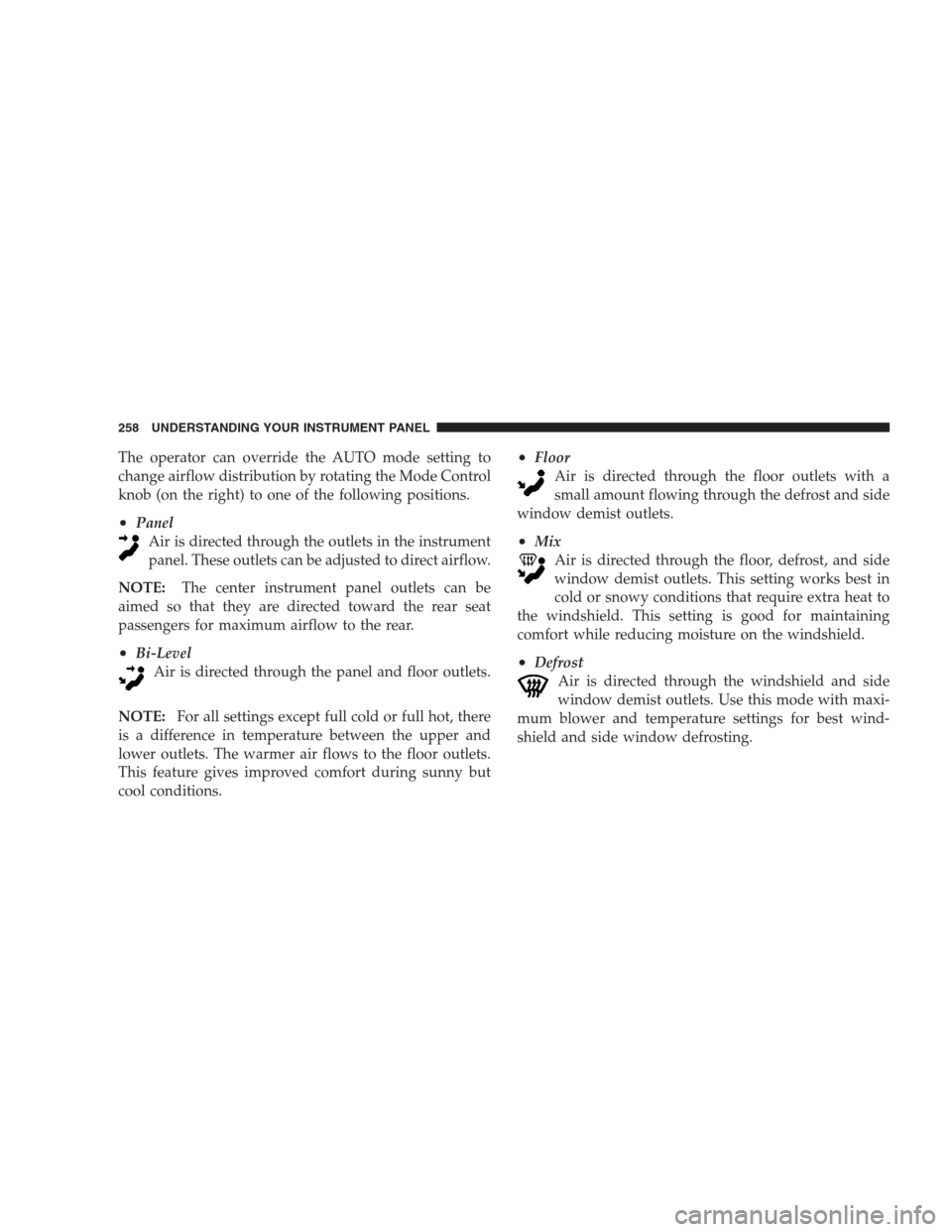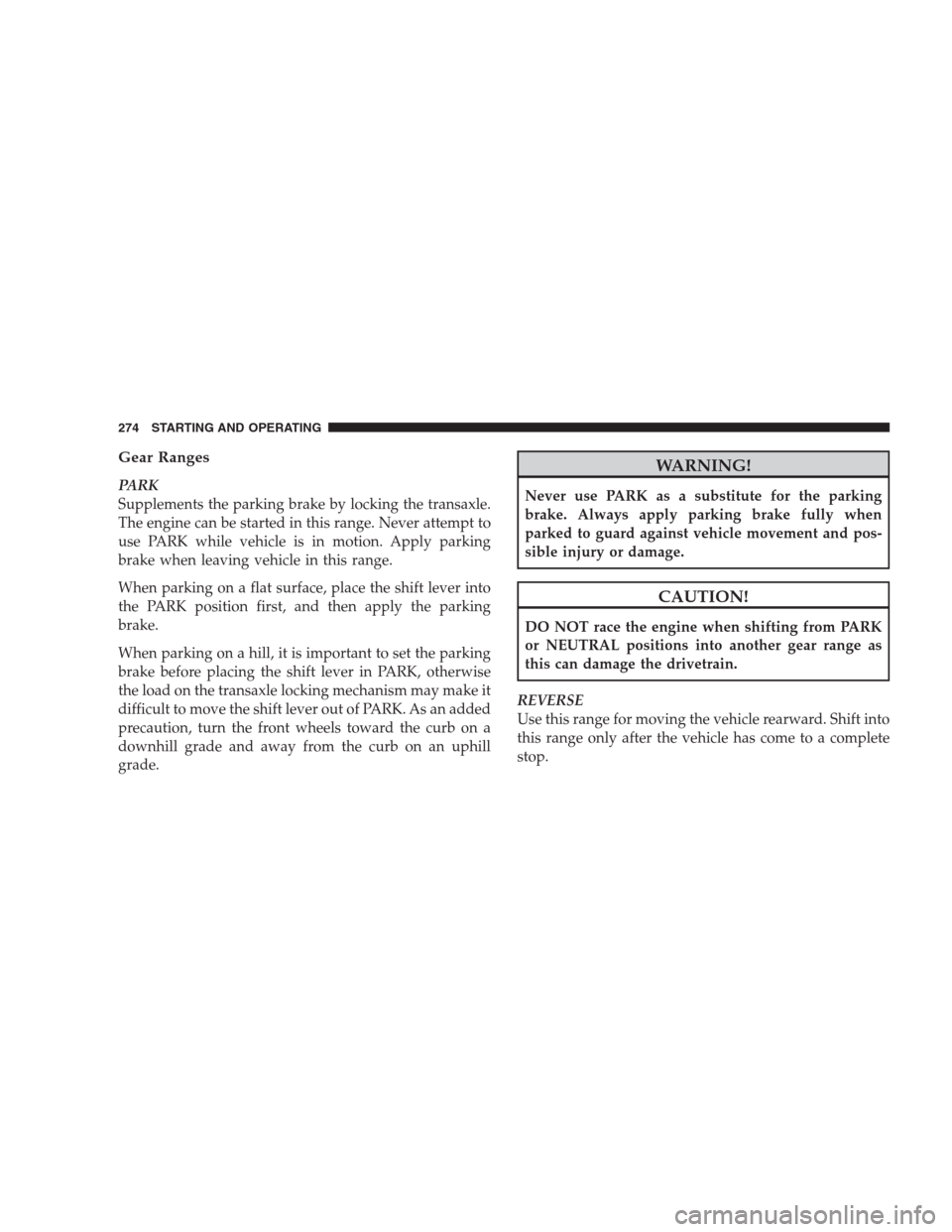Page 260 of 475

The operator can override the AUTO mode setting to
change airflow distribution by rotating the Mode Control
knob (on the right) to one of the following positions.
•Panel
Air is directed through the outlets in the instrument
panel. These outlets can be adjusted to direct airflow.
NOTE:The center instrument panel outlets can be
aimed so that they are directed toward the rear seat
passengers for maximum airflow to the rear.
•Bi-Level
Air is directed through the panel and floor outlets.
NOTE:For all settings except full cold or full hot, there
is a difference in temperature between the upper and
lower outlets. The warmer air flows to the floor outlets.
This feature gives improved comfort during sunny but
cool conditions.
•Floor
Air is directed through the floor outlets with a
small amount flowing through the defrost and side
window demist outlets.
•Mix
Air is directed through the floor, defrost, and side
window demist outlets. This setting works best in
cold or snowy conditions that require extra heat to
the windshield. This setting is good for maintaining
comfort while reducing moisture on the windshield.
•Defrost
Air is directed through the windshield and side
window demist outlets. Use this mode with maxi-
mum blower and temperature settings for best wind-
shield and side window defrosting.
258 UNDERSTANDING YOUR INSTRUMENT PANEL
Page 263 of 475

Window Fogging
Interior fogging on the windshield can be quickly re-
moved by turning the mode selector to Defrost. The
Defrost/Floor mode can be used to maintain a clear
windshield and provide sufficient heating. If side win-
dow fogging becomes a problem, increase blower speed.
Vehicle windows tend to fog on the inside in mild but
rainy or humid weather.
NOTE:Recirculate without A/C should not be used for
long periods as fogging may occur.
Side Window Demisters
A side window demister outlet is located at each end of
the instrument panel. These non-adjustable outlets direct
air toward the side windows when the system is in the
FLOOR, MIX, or DEFROST mode. The air is directed at
the area of the windows through which you view the
outside mirrors.
Outside Air Intake
Make sure the air intake, located directly in front of the
windshield, is free of obstructions such as leaves. Leaves
collected in the air intake may reduce airflow, and if they
enter the plenum, they could plug the water drains. In
winter months, make sure the air intake is clear of ice,
slush, and snow.
A/C Air Filter — If Equipped
The A/C Filter prevents most dust and pollen from
entering the cabin. The filter acts on air coming from
outside the vehicle and recirculated air within the pas-
senger compartment. Refer to “Maintenance Procedures”
in Section 7 of this manual for A/C Air Filter service
information or see your authorized dealer for service.
Refer to the “Maintenance Schedules” in Section 8 of this
manual for filter service intervals.
UNDERSTANDING YOUR INSTRUMENT PANEL 261
4
Page 268 of 475

▫Starting........................... 333
▫Cruising Range...................... 333
▫Replacement Parts................... 333
▫Maintenance........................ 334
�Adding Fuel......................... 334
▫Fuel Filler Cap (Gas Cap).............. 334
▫Loose Filler Cap Message.............. 336
�Vehicle Loading...................... 337
▫Vehicle Certification Label.............. 337
▫Gross Vehicle Weight Rating (GVWR)...... 337
▫Gross Axle Weight Rating (GAWR)........ 337
▫Overloading........................ 338
▫Loading........................... 338�Trailer Towing........................ 339
▫Common Towing Definitions............ 339
▫Trailer Hitch Classification.............. 341
▫Trailer Towing Weights (Maximum Trailer
Weight Ratings)..................... 342
▫Trailer And Tongue Weight............. 343
▫Towing Requirements................. 344
▫Towing Tips........................ 347
�Recreational Towing
(Behind Motorhome, Etc.)................ 349
▫Towing This Vehicle Behind Another Vehicle
(Flat Towing With All Four Wheels On The
Ground)........................... 349
266 STARTING AND OPERATING
Page 271 of 475

WARNING! (Continued)
•Do not attempt to push or tow your vehicle to get
it started. Vehicles equipped with an automatic
transmission cannot be started this way. Unburned
fuel could enter the catalytic converter and once
the engine has started, ignite and damage the
converter and vehicle. If the vehicle has a dis-
charged battery, booster cables may be used to
obtain a start from a booster battery or the battery
in another vehicle. This type of start can be dan-
gerous if done improperly. Refer to Section 6 for
proper jump-starting procedures and follow them
carefully.
If the engine fails to start after you have followed the
“Normal Starting” or “Extreme Cold Weather” proce-
dures, it may be flooded. To clear any excess fuel, push
the accelerator pedal all the way to the floor and hold it.
Then, turn the ignition switch to the START position andrelease it as soon as the starter engages. The starter motor
will disengage automatically in 10 seconds. Once this
occurs, release the accelerator pedal, turn the ignition
switch to the LOCK position, wait 10 to 15 seconds, then
repeat the normal starting procedure.
CAUTION!
To prevent damage to the starter, do not crank the
engine for more than 15 seconds at a time. Wait 10 to
15 seconds before trying again.
After Starting
The idle speed will automatically decrease as the engine
warms up.
STARTING AND OPERATING 269
5
Page 276 of 475

Gear Ranges
PARK
Supplements the parking brake by locking the transaxle.
The engine can be started in this range. Never attempt to
use PARK while vehicle is in motion. Apply parking
brake when leaving vehicle in this range.
When parking on a flat surface, place the shift lever into
the PARK position first, and then apply the parking
brake.
When parking on a hill, it is important to set the parking
brake before placing the shift lever in PARK, otherwise
the load on the transaxle locking mechanism may make it
difficult to move the shift lever out of PARK. As an added
precaution, turn the front wheels toward the curb on a
downhill grade and away from the curb on an uphill
grade.
WARNING!
Never use PARK as a substitute for the parking
brake. Always apply parking brake fully when
parked to guard against vehicle movement and pos-
sible injury or damage.
CAUTION!
DO NOT race the engine when shifting from PARK
or NEUTRAL positions into another gear range as
this can damage the drivetrain.
REVERSE
Use this range for moving the vehicle rearward. Shift into
this range only after the vehicle has come to a complete
stop.
274 STARTING AND OPERATING
Page 277 of 475

NEUTRAL
Engine may be started in this range.
WARNING!
Do not coast in NEUTRAL and never turn off the
ignition to coast down a hill. These are unsafe
practices that limit your response to changing traffic
or road conditions. You might lose control of the
vehicle and have an accident.
DRIVE – 6 Speed Transaxle
This range should be used for most city and highway
driving. It provides the smoothest upshifts, downshifts,
and best fuel economy. However, use the AutoStick�
mode and select the appropriate gear when frequent
transaxle shifting occurs in the DRIVE range. For ex-
ample: When operating the vehicle under heavy loading
conditions, (i.e. in hilly terrain, traveling into strong
headwinds, or while towing heavy trailers). Under theseconditions, reducing shifting by selecting the appropriate
gear in AutoStick�will improve the performance and
extend transmission life by reducing excessive shifting
and heat build-up.
DRIVE – 4 Speed Transaxle
This range should be used for most city and highway
driving, it provides the smoothest upshifts, downshifts,
and best fuel economy. However, select the�3�range
when frequent transaxle shifting occurs while using the
DRIVE range, such as when operating the vehicle under
heavy loading conditions, (i.e. in hilly terrain, traveling
into strong headwinds, or while towing heavy trailers).
Under these conditions, using the�3�range will improve
performance and extend transaxle life by reducing exces-
sive shifting and heat build-up.
STARTING AND OPERATING 275
5
Page 279 of 475

In the event of a momentary problem, the transaxle can
be reset to regain all forward gears by performing the
following steps:
1. Stop the vehicle.
2. Shift the shift lever into PARK.
3. Turn the ignition switch to the LOCK position.
4. Restart the engine.
5. Shift the shift lever into the desired gear range and
resume driving.
NOTE:Even if the transaxle can be reset, it is recom-
mended that you visit a dealer at your earliest possible
convenience. Your dealer has diagnostic equipment to
determine if the problem could recur.
If the transaxle cannot be reset, dealer service is required.AUTOSTICK�— IF EQUIPPED
AutoStick�is a driver-interactive transaxle that offers six
manual ratio changes to provide you with more control
of the vehicle. AutoStick�allows you to maximize engine
braking, eliminate undesirable upshifts and downshifts,
and improve overall vehicle performance. This system
can also provide you with more control during passing,
city driving, cold slippery conditions, mountain driving,
trailer towing, and many other situations.
Operation
By placing the shift lever one shift-level below the DRIVE
position, it can be moved from side to side. This allows
the driver to select a higher or lower range of gears.
Moving the shift lever to the Left (-) triggers a downshift
and to the Right (+) an upshift. The gear position will
display in the instrument cluster on the transaxle range
indicator.
STARTING AND OPERATING 277
5
Page 286 of 475
As an added precaution, turn the front wheels toward the
curb on a downhill grade and away from the curb on an
uphill grade.
To apply the parking brake, grasp the handle and pull it
upward until you feel resistance. To release the parking
brake, grasp the handle and pull it slightly while pressing
the button on the end of the handle. When the button
drops into the handle (releasing the lock), guide the
handle downward to its stop, and then release the button
and the handle.
NOTE:
•The parking brake will not release unless the handle is
pulled upward slightly past its applied position.
Parking Brake
284 STARTING AND OPERATING